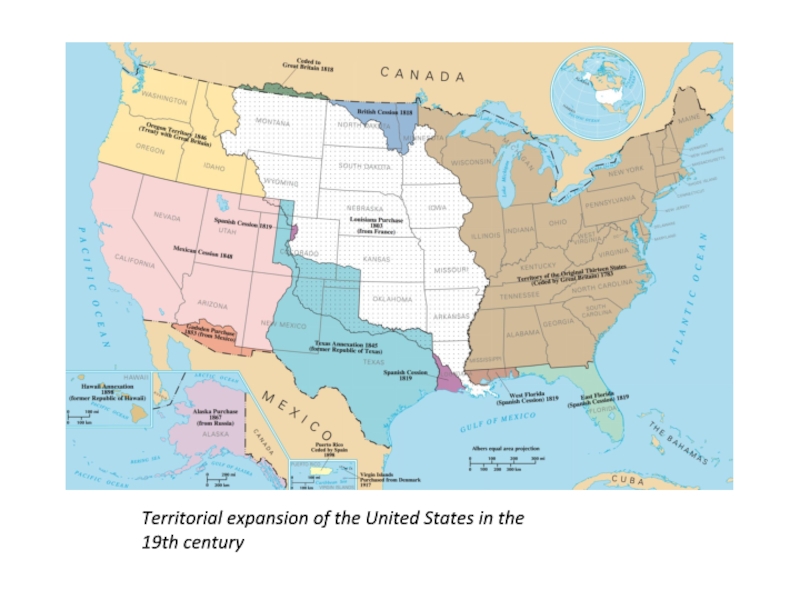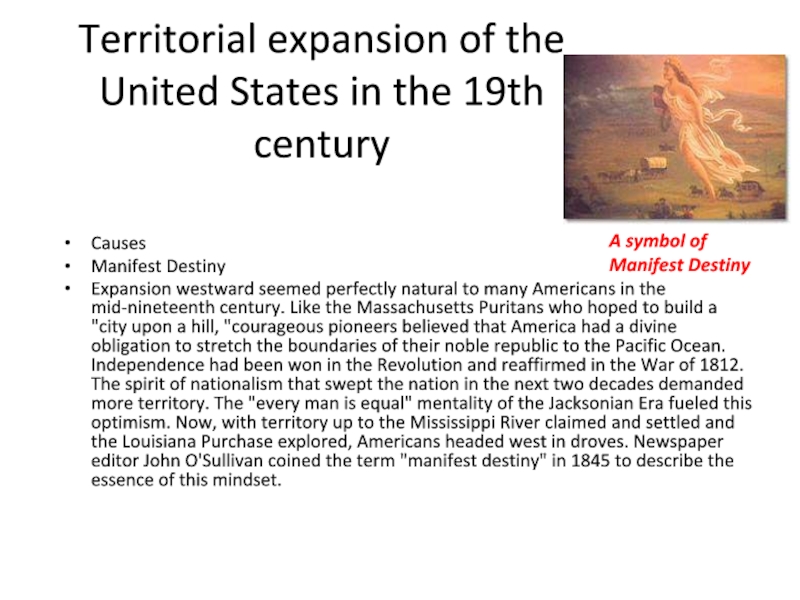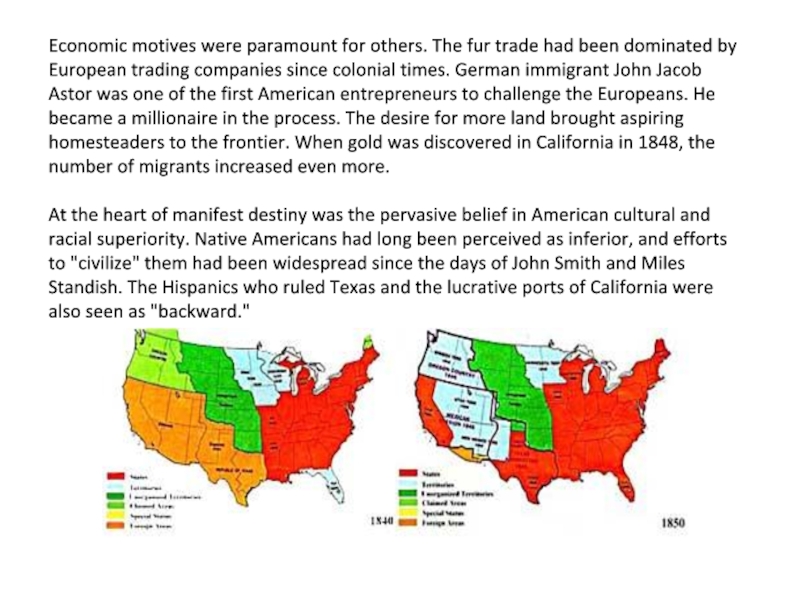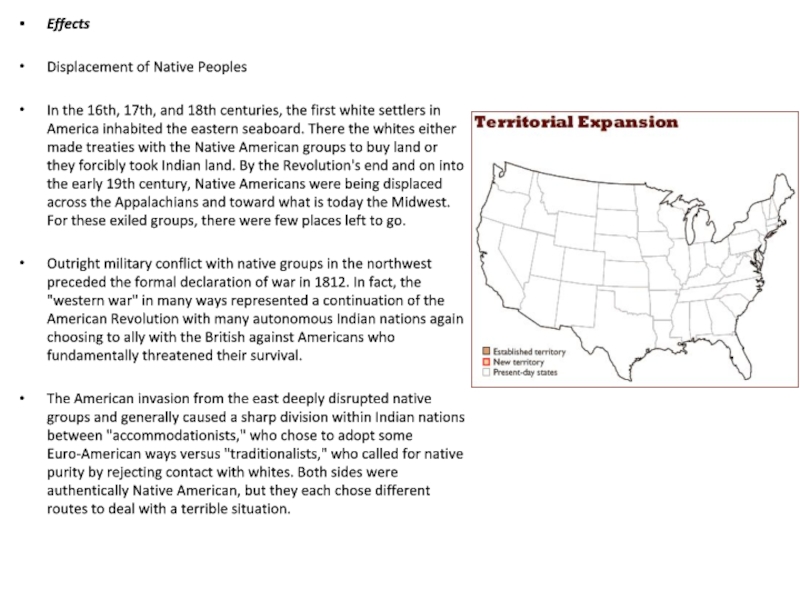- Главная
- Разное
- Дизайн
- Бизнес и предпринимательство
- Аналитика
- Образование
- Развлечения
- Красота и здоровье
- Финансы
- Государство
- Путешествия
- Спорт
- Недвижимость
- Армия
- Графика
- Культурология
- Еда и кулинария
- Лингвистика
- Английский язык
- Астрономия
- Алгебра
- Биология
- География
- Детские презентации
- Информатика
- История
- Литература
- Маркетинг
- Математика
- Медицина
- Менеджмент
- Музыка
- МХК
- Немецкий язык
- ОБЖ
- Обществознание
- Окружающий мир
- Педагогика
- Русский язык
- Технология
- Физика
- Философия
- Химия
- Шаблоны, картинки для презентаций
- Экология
- Экономика
- Юриспруденция
Territorial expansion of the United States in the 19th century презентация
Содержание
Слайд 2Territorial expansion of the United States in the 19th century
Causes
Manifest Destiny
Expansion
westward seemed perfectly natural to many Americans in the mid-nineteenth century. Like the Massachusetts Puritans who hoped to build a "city upon a hill, "courageous pioneers believed that America had a divine obligation to stretch the boundaries of their noble republic to the Pacific Ocean. Independence had been won in the Revolution and reaffirmed in the War of 1812. The spirit of nationalism that swept the nation in the next two decades demanded more territory. The "every man is equal" mentality of the Jacksonian Era fueled this optimism. Now, with territory up to the Mississippi River claimed and settled and the Louisiana Purchase explored, Americans headed west in droves. Newspaper editor John O'Sullivan coined the term "manifest destiny" in 1845 to describe the essence of this mindset.
A symbol of Manifest Destiny
Слайд 3Economic motives were paramount for others. The fur trade had been
dominated by European trading companies since colonial times. German immigrant John Jacob Astor was one of the first American entrepreneurs to challenge the Europeans. He became a millionaire in the process. The desire for more land brought aspiring homesteaders to the frontier. When gold was discovered in California in 1848, the number of migrants increased even more.
At the heart of manifest destiny was the pervasive belief in American cultural and racial superiority. Native Americans had long been perceived as inferior, and efforts to "civilize" them had been widespread since the days of John Smith and Miles Standish. The Hispanics who ruled Texas and the lucrative ports of California were also seen as "backward."
At the heart of manifest destiny was the pervasive belief in American cultural and racial superiority. Native Americans had long been perceived as inferior, and efforts to "civilize" them had been widespread since the days of John Smith and Miles Standish. The Hispanics who ruled Texas and the lucrative ports of California were also seen as "backward."
Слайд 4
Effects
Displacement of Native Peoples
In the 16th, 17th, and 18th centuries, the
first white settlers in America inhabited the eastern seaboard. There the whites either made treaties with the Native American groups to buy land or they forcibly took Indian land. By the Revolution's end and on into the early 19th century, Native Americans were being displaced across the Appalachians and toward what is today the Midwest. For these exiled groups, there were few places left to go.
Outright military conflict with native groups in the northwest preceded the formal declaration of war in 1812. In fact, the "western war" in many ways represented a continuation of the American Revolution with many autonomous Indian nations again choosing to ally with the British against Americans who fundamentally threatened their survival.
The American invasion from the east deeply disrupted native groups and generally caused a sharp division within Indian nations between "accommodationists," who chose to adopt some Euro-American ways versus "traditionalists," who called for native purity by rejecting contact with whites. Both sides were authentically Native American, but they each chose different routes to deal with a terrible situation.
Outright military conflict with native groups in the northwest preceded the formal declaration of war in 1812. In fact, the "western war" in many ways represented a continuation of the American Revolution with many autonomous Indian nations again choosing to ally with the British against Americans who fundamentally threatened their survival.
The American invasion from the east deeply disrupted native groups and generally caused a sharp division within Indian nations between "accommodationists," who chose to adopt some Euro-American ways versus "traditionalists," who called for native purity by rejecting contact with whites. Both sides were authentically Native American, but they each chose different routes to deal with a terrible situation.









